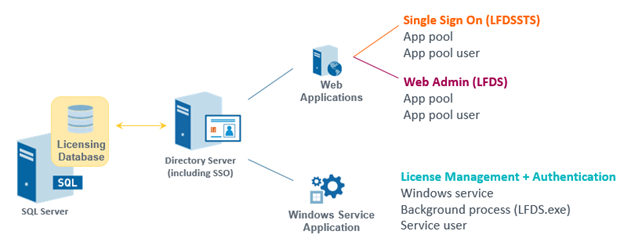Laserfiche Directory Server is a license management server for Laserfiche Rio. It manages user accounts and applications licenses across your Laserfiche suite. Directory Server gives users a single sign-on experience—they can navigate from one Laserfiche application to another without having to re-enter their username and password.
Architecture
Understanding the architecture of Laserfiche Directory Server in relation to other Laserfiche applications can help you better design your Laserfiche system and troubleshoot problems.
The Directory Server itself consists of the server itself and a licensing database (commonly referred to as a licensing site). The server has a Windows service, which runs as a background process named LFDS.exe. The database can be on the same computer as the server, or on a different computer.

Laserfiche web applications like Forms, the web client, and the mobile App connect to Directory Server to authenticate. More precisely, they connect to a security token service (STS) instance, which can be hosted either on the same computer as Directory Server, or on a different computer. We’ll represent the STS instance with the ![]() icon, indicating a sign-in page.
icon, indicating a sign-in page.
Components
Each component of Laserfiche Directory Server performs a different function.
- The licensing database stores information about user licenses and application licenses.
- The Windows service, LFDS.exe, handles the logic of licensing and authentication. It runs using a service user that you can define. By default, the service user is a built-in system account such as LocalSystem or NetworkService.
- The STS instance
 is the endpoint that users authenticate to. Users do not authenticate directly to Directory Server—the endpoint passes their information on to Directory Server.
is the endpoint that users authenticate to. Users do not authenticate directly to Directory Server—the endpoint passes their information on to Directory Server.
Note: Laserfiche Directory Server handles authentication, not authorization. Authentication determines whether users can sign in to an application. Authorization determines what users can do within each application. It’s possible for users to authenticate successfully to an application, but be unable to perform the tasks they want. In that case, you should troubleshoot either the type of license the user has, or the application’s security settings, rather than Directory Server. Directory Server determines only if users can sign in to an application.
Next Steps
Learn more about Laserfiche licensing:
- Laserfiche Rio Licensing
- Laserfiche Licensing white paper: This contains more details, including comparisons with non-Laserfiche Rio systems and details of application licensing.
Learn more about installing and configuring Laserfiche Directory Server:
- Installing Laserfiche Directory Server - See system requirements prior to installing Laserfiche Directory Server.
- Initial Configuration - Learn more about creating a Directory Server licensing site.
- Configuring a primary License - Learn more about associating a primary license with a licensing site.